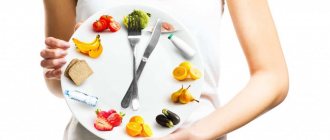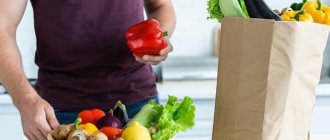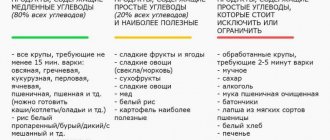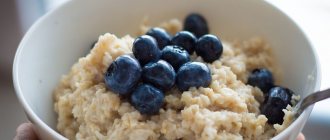Most of us are not very patient when it comes to losing weight. We want to get results as soon as possible, without even thinking that there are certain limits to how much weight you can lose in a week.
The reality is that if your goal is to lose a significant amount of kilograms, then you definitely won’t do it in one day.
But you can definitely lose a certain amount of weight per week by following the right diet and regular exercise (but the greater effect will still come from the diet).
Most people find it easiest to set weekly weight loss goals. With this approach, excess weight does not seem so threatening, and there are fewer reasons to give up before you even start.
Judge for yourself, losing 25 kilograms in an indefinite period of time sounds quite threatening. It is not clear how long this will take - one, two months or maybe one year. And losing a kilogram in 1 week looks like a completely feasible goal. Moreover, in order to lose these same 25 kilograms you will need only 25 weeks, which is not so long.
And we come straight to the main question: how much can you lose as much as possible in a week without harm to your health and taking into account the fact that the main goal is to lose weight as quickly as possible.
Minus 2 kg on a low-calorie diet
Since the diet is called low-calorie, it becomes clear that weight loss is achieved by cutting down on daily kilocalorie intake. To achieve tangible results, it is necessary to count the number of kilocalories contained in all food products consumed. Therefore, such a diet is not for lazy people. If the menu is compiled incorrectly, you will not be able to lose weight. It is very important to consider the calorie content of each meal.
Diet principles
In order for the extra pounds to begin to go away, the calorie content of a woman’s daily menu should not exceed 1500 kcal. In some cases, it is recommended to reduce it to 1000 kcal. The strictest diet is considered to be one whose caloric intake is 800 kcal per day, but doctors do not recommend adhering to such a diet, as it can be harmful to health.
In order for a low-calorie diet to give the desired result, it is necessary to build it based on the following principles:
- The calorie content of the daily diet should be reduced by 20-30%. Moreover, from the menu, first of all, you need to remove foods containing fats and simple carbohydrates.
- The emphasis should be on protein dishes, in this case muscle mass will not “burn”, only fat reserves will be lost.
- It is necessary to exclude so-called “fast” carbohydrates from the menu - sugar, confectionery, sweet drinks, bread made from premium white flour.
- It is recommended to limit your daily salt intake.
- Alcohol is removed from the menu completely.
- You need to eat food at least 5 times a day, in small portions.
Permitted and prohibited products
Products used for cooking must be low in calories, but contain the maximum range of vitamins and microelements.
The list of prohibited and permitted products is as follows:
- Wheat bread is replaced with rye bread, which is baked from wholemeal flour. All products made from premium flour are prohibited, the same applies to baked goods and puff pastries.
- A serving of soup should be 250-300 ml. Soups should be prepared from vegetables; you can add a little grain to them. It is good to include cabbage soup, borscht, rassolnik, okroshka, and beetroot soup in the menu. It is also allowed to cook soup using lean meat, skinless poultry and fish. Potato soups, legumes, milk soups with pasta, and thick cereal soups are prohibited.
- Meat products such as lean beef, veal, and pork are allowed. You can use rabbit or poultry meat (turkey, chicken), lean fish (cod, pike perch, pike) for cooking; you can eat beef jelly. The following types of meat are prohibited: duck, goose, and lamb. Do not eat sausages, small sausages, sausages, ham, or canned meat.
- Allowed seafood: scallops, oysters, mussels, shrimp, squid. Prohibited seafood: oily canned fish, fish roe, smoked and salted fish.
- Allowed dairy products: milk and fermented milk drinks (fat content up to 1.5%), cottage cheese (fat content up to 5%), low-fat cheeses. Prohibited dairy products: all fatty and salty cheeses, full-fat cottage cheese, glazed cheese curds, sweet yogurt, fermented baked milk, cream, milk with a fat content of more than 1.5%.
- You can eat 3-4 eggs per week. They can be cooked in any way except frying.
- Cereals can be consumed in limited quantities; they are good to add to soups. You can cook buckwheat, pearl barley and barley porridge, but in small portions. Cereals such as rice and semolina are prohibited. You should not eat pasta.
- Vegetables that can be eaten without restrictions: tomatoes, cucumbers, fresh cabbage, celery, lettuce, radishes, radish, eggplant, zucchini, pumpkin, seaweed. Mushrooms are also allowed. Vegetables that should be limited: potatoes, carrots, beets, all pickled and salted vegetables.
- It is allowed to eat fruits and berries whose calorie content does not exceed 45 kcal per 100 g. Among them: watermelon, cranberries, tangerines, cherry plums, lemons, blackberries, cloudberries, oranges, grapefruit, kiwi, peaches, apples, quince, strawberries, blueberries etc. The following are prohibited: bananas, dates, raisins, grapes.
- Desserts that can be included in the menu: mousses and jellies prepared with sorbitol, xylitol, methylcellulose. Prohibited: honey, jelly, ice cream, sweet drinks, jam.
- Butter and vegetable oils can be consumed in limited quantities. Cooking fats and meat fat are completely prohibited.
- Allowed drinks: berry juices, tea, coffee, fruit juices with pulp. Prohibited drinks: grape juice, cocoa.
Menu for 7 days
| Breakfast first | Breakfast second | Main meal | Snack | Dinner | |
| 1 | Oatmeal porridge with water, a tablespoon of raisins, coffee. | A glass of kefir, some bread. | 100 g chicken breast, 100 g brown rice, tomato, water. | Yogurt 1.5% fat, kiwi. | Vegetable salad, bread. |
| 2 | Buckwheat porridge with vegetable oil, coffee. | 150 g cottage cheese, apple, still water. | Vegetables with beef, tea. | Juice, bread. | Grilled fish, lettuce with lemon juice and green tea. |
| 3 | Boiled egg, coffee, 2 loaves of bread. | 10 pieces of nuts, pear, water. | 50 g of cheese, seafood with lemon juice in the form of salad, tea. | Kefir with herbs. | Steamed chicken egg white omelet, salad with tomatoes and herbs, still water. |
| 4 | Oatmeal with water, grapefruit, coffee. | 200 cottage cheese with 0% fat, radishes with herbs, green tea. | Stewed veal meat (150 g), green peas, water. | Stew with tomatoes, mushrooms and onions, black tea. | Boiled potatoes, lettuce, water. |
| 5 | Bread, dried apricots, cheese, coffee. | Egg, vegetable juice. | Solyanka with mushrooms, green tea. | Cottage cheese with 0% fat, apple, black tea. | Grilled cod, lettuce with lemon juice dressing, green tea. |
| 6 | Buckwheat porridge with olive oil (tablespoon), coffee. | Cheese, tomatoes with herbs. | Lean grilled fish, 1 boiled potato, vegetable salad, green tea. | Orange, a glass of yogurt with 1.5% fat content. | 200 g boiled shrimp, lettuce, still water. |
| 7 | Cottage cheese, berries, black tea. | A glass of sour milk bread. | Fish in the oven, vegetable salad, still water. | Boiled egg, apple, green tea. | Cabbage salad, boiled lean meat (150 g), still water. |
Advantages and disadvantages
The advantages of a low-calorie diet include the following:
- Products for cooking are inexpensive and can be purchased at any store.
- The diet is safe for health.
- The result will last for a long time.
- The diet is easily tolerated, as it does not require a radical change in eating habits.
- There is no need to see a doctor, since the diet does not put the body into a state of stress and does not harm it.
The disadvantages of a low-calorie diet are as follows:
- Portions will need to be reduced significantly. The feeling of hunger can provoke the occurrence of neuroses and the development of depression.
- If you choose foods low in vitamins and microelements, this can cause vitamin deficiency.
- You will have to count not only the number of kilocalories, but also study the composition of the products used to prepare dishes.
How long does it take to lose 10 kg?
How long does it take to lose 10 kg realistically? Nutritionists and fitness trainers say that the ideal option is a month. This goal is quite realistic. In a week you will lose about 2-3 kg. It is enough to reduce the calorie intake, introduce an effective diet and follow the recommendations.
But you can lose 10 kg in a year even without low-calorie diets. To do this, just follow the rules for effective weight loss, and you can eat whatever you want.
The number of kilograms lost also depends on the initial weight. The more it is, the easier the first kilograms will come off.
Losing a lot of weight in a few days or weeks is unrealistic. This is a real utopia for the body. As a result, after the diet the kilograms will return again.
It is important that weight loss be smooth and balanced in order to prevent the development of diseases, damage to the gastrointestinal tract or cardiovascular system.
Minus 2 kg on a vegetable diet
A vegetable diet is one of the healthiest. Plus, it can be very tasty. By following this diet plan, you can lose from 2 to 7 kg. Specific numbers depend on the individual characteristics of the body.
It is good to stick to a vegetable diet for people with high blood pressure and obese patients. It is best to start losing weight using the proposed method in the summer or in the first autumn months. At this time, vegetables are presented in abundance on store shelves, and their prices are very affordable. It is not recommended to practice this diet more than once a year.
Principles of diet.
You need to eat 1.5 kg of vegetables per day. They can be cooked or eaten raw. You can eat a meat dish twice a week, but you should choose lean meat. Dairy products (sour cream, cottage cheese, yogurt, milk) and corn flakes are also allowed.
It is best to choose yellow or green vegetables.
It is important to drink at least 1.5 liters of clean water per day.
Permitted and prohibited products
Allowed foods on a vegetable diet:
- Tomatoes and cucumbers;
- Zucchini and eggplant;
- Cabbage and carrots;
- Onion;
- Lettuce, sweet pepper, radish;
- Beans;
- Mushrooms;
- Green apples, watermelon, melon, peaches, apricots;
- Kefir, milk, cottage cheese, yogurt with 0% fat content;
- Oat groats;
- Rye bread;
- Eggs.
Products should be eaten raw; they can be steamed, boiled, or grilled. Salads should be seasoned with olive oil and lemon juice. You can lightly salt the dishes and add some spices to them. It’s good if you can replace the salt with soy sauce.
The following foods should not be eaten:
- Lard, fatty meats, sausage;
- Baking, confectionery;
- Fatty broths;
- Mayonnaise.
Menu for 7 days
| 1 breakfast | 2 breakfast | dinner | snack | dinner | |
| 1 | Kefir, fruit, toast with olive oil, tomato and herbs. | Fruit. | Sorrel and spinach with garlic butter dressing, vegetables with rice. | Fruit. | Risotto. |
| 2 | Fruit, pita bread with basil and hummus, tea with mint leaves. | Tomato with cheese and arugula. | Ratatouille, celery and cheese. | Fruit. | Zucchini with cheese in the oven. |
| 3 | Fruit, toast with avocado, sesame seeds and olive oil, hot chocolate with milk. | Fruit. | Fresh vegetable, piece of whole grain bread, tabbouleh. | Fruit. | Lobio with tomatoes and nuts. |
| 4 | Fruit, toast with guacamole, tea. | Fruit. | Celery with salsa, tomatoes in the oven. | Fruit. | Pilaf with zucchini. |
| 5 | Salad with pepper and eggplant, tea. | Fruit. | Bread with pkhali, chanfotta. | Apple smoothie. | Grilled vegetables. |
| 6 | Toast with vegetable caviar, plums with honey, herbal infusion. | Beetroot with fennel in the oven. | Adjapsandali, cottage cheese with honey and nuts. | Fruit. | Eggplants with tomatoes and cheese in the oven. |
| 7 | Omelette with egg, garlic, zucchini and sweet pepper, tea. | Fruit. | Green lobio with tomatoes, stew with mussels. | Fresh vegetable. | Fettuccine with zucchini. |
Advantages and disadvantages
The advantages of a vegetable diet include the following:
- The complexion becomes healthy and even.
- The condition of hair and nails improves.
- You feel a surge of vitality and lightness appears in your body.
- Relapses of chronic diseases are less common concerns.
- The weight is steadily coming off.
- The body's defenses increase.
- Mood improves, depression goes away.
One should not get carried away with a vegetable diet, since a person needs protein of animal origin. It is not sufficiently extracted from plant foods. Without animal protein, the normal functioning of body cells is impossible, since it is the main building material for them. Therefore, you should not practice a vegetable diet for more than a week (maximum 9 days).
Experts recommend organizing fasting days on vegetables.
During the diet, you should avoid playing sports. You can only do short runs and do morning exercises.
Another disadvantage of a vegetable diet is the likelihood of intestinal upset, since the main emphasis during the diet is on foods containing a lot of fiber.
Physical exercise
How can you lose weight in a week with physical exercise? If you are rapidly losing weight by eating low-calorie foods, you should be careful with strength training. Suitable and enjoyable sports activities for weight loss:
- jogging in the fresh air;
- home exercises;
- cardio loads;
- dancing.
Experts recommend setting aside at least 30 minutes. for intensive training. It is advisable to focus on the hips and abdomen.
Leg exercise
Various squats are useful to reduce volume in the upper legs. They are performed with weights (dumbbells or water bottles). Extra pounds will go away faster if you do swings, lunges and knee raises. To strengthen the arms and back, they are combined with a bar.
Aerobic exercise for the abdomen and thighs
How to lose weight in 1 week in the abdominal area? For this area, training aimed at working the abdominal muscles will bring good results:
- reverse and straight crunches;
- raising the body;
- lifting legs vertically and at an angle.
To get rid of excess body weight, it is useful to do exercises with a chair. They sit on it with their hands resting on the seat and their legs raised up. The training is performed in sets of 15-25 rubles, stopping for a short time to rest. The total training time is 20 minutes.
How to lose weight in the thigh area in a week? This problem area is difficult to correct. To work out this part of the body, intense leg swings with muscle pumping are suitable.
Sticking to strict diets requires good health and willpower. A good alternative would be a combination of exercise and a healthy diet. By leading an active lifestyle, you can tidy up your body, lose weight and improve your well-being. First, you should eat right and exercise for 1 week, and then adhere to the rules of a healthy diet to maintain a stable shape.
Minus 2 kg on a vegetarian diet
A vegetarian diet is one of the most popular weight loss methods among women around the world. It occupies almost a leading position in the overall diet system. Although the vegetarian diet seems one-sided at first glance, it is very balanced.
A vegetarian diet allows you not only to get rid of excess weight, but also to improve your own health and well-being.
Diet principles
Any variation of a vegetarian diet is based on the following principles:
- All products on the menu must be of plant origin.
- Animal fats and proteins are replaced with plant analogues.
- Salads and prepared dishes should be seasoned with olive oil. Mayonnaise and other fatty sauces should not be used for this purpose.
- Dishes can be boiled, steamed or baked.
- Harmful foods should be replaced with healthy ones: sweets with dried fruits, sparkling water with tea, sugar with honey.
- It is important to drink at least 2 liters of water per day.
- Before you start losing weight with a vegetarian diet, you need to make sure that there are no contraindications to it.
- The menu should be as varied as possible, which will saturate the body with the necessary vitamins and microelements.
Permitted and prohibited products
During a vegetarian diet, you can eat the following foods:
- Cereals, nuts, bread, muesli, oatmeal, rice, buckwheat, peas, lentils, beans, pasta, couscous, pumpkin seeds, sesame seeds, raisins.
- Vegetables: potatoes, onions, spinach, eggplant, zucchini, carrots, greens, pumpkin, tomatoes, cucumbers, celery, ginger root, lemons, garlic, broccoli, avocado, sweet peppers, beets, corn, green peas.
- Herbs: rosemary, oregano, basil, etc.
- Seasonings: coriander, cinnamon, cumin, black pepper.
- Olive and sesame oil.
- Still mineral water.
- Sour cream, yogurt, homemade mayonnaise, butter.
- Cheeses: suluguni, mozzarella, parmesan, feta, feta cheese.
- Salt.
- Black chocolate.
- Flour, soda, starch.
The menu must include products from the table presented:
| Fruits | Vegetables | Olive oil | Decaffeinated coffee |
| Potato | Barley | Green tea | Unpeeled rice |
| Legumes | Cereals | Vegetable paste | Cereal paste |
| Nuts | Tofu | Canola oil | Coconut oil |
| Soybeans | Water | Corn chips | Corn tortillas |
Menu for 7 days
| First meal | Main meal | Dinner | |
| 1 | Buckwheat | Vegetable soup, fruit salad, fried bran bread | Boiled turnips, steamed eggplants and beets |
| 2 | Cottage cheese, berries, low-fat yogurt | Mushroom soup, borscht, potatoes, green vegetable salad, two apples | Boiled broccoli, a glass of curdled milk, bran bread |
| 3 | 2 boiled eggs, toast with tomatoes, cheese | Apple and celery salad, spices | Stewed beets with zucchini, rye bread |
| 4 | Bifilife, boiled egg, carrots, greens | Marinated corn, rice, bell pepper with champignons, two oranges | Stewed vegetables, mushrooms |
| 5 | Rice, pear, apple, homemade yogurt | Yellow and red vegetables, grapefruit, grain bread | Oven potatoes, tomato, celery with vegetable oil |
| 6 | Banana, stewed vegetables, egg, yogurt | Soup with vegetables, 2 kiwis, seaweed | Baked vegetables |
| 7 | Any breakfast that was offered during the week | Any lunch of your choice | Any dinner of your choice |
Myths that prevent you from losing weight
On the Internet you can find a large amount of false information about losing weight from people who are incompetent in this matter. Some myths include:
1. There is an opinion that during weight loss, fat mass turns into muscle mass. This is incorrect, since they are completely different in structure and chemical composition and cannot pass over each other. Muscle mass is built up through exercise.
2. Exercise machines designed for problem areas help you lose weight – these exercise kits tend to do everything for the individual. There is no burning of calories.










